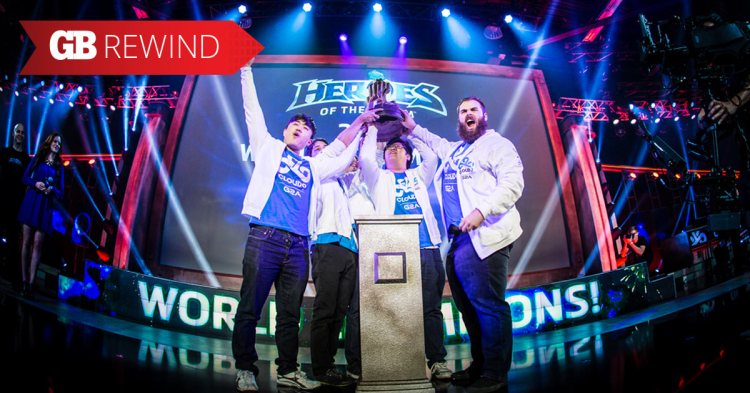In the past several years, and for what will likely be several more, every year has been — and will continue to be — the biggest year in esports.
We set precedents, held epic tournaments, and caused controversies — it was an incredible year, after all. Whether you saw them live or rarely had a chance, too many phenomenal events to count were held in 2015. These are five that deserve a look back as we’re on the cusp of 2016.
Counter-Strike: Global Offensive
This is cheating, I know. But picking just one Counter-Strike: Global Offensive (CS:GO) event out of 2015 feels almost impossible. 2015 was the year of CS:GO in every way — a massive resurrection of the CS scene, with over $6 million dollars in prize money awarded (moving CS:GO into the top five esports by earnings of all time, and the third largest game in 2015).
Fnatic has been immensely successful since CS:GO’s triumphant return in late 2013 with the Dreamhack Winter Major that year. They remain the most successful CS:GO team in the world in almost every regard — most prize money won, most tournaments won, most Majors won. Despite this success, one of the biggest highlights of the year had to be the final Major at Dreamhack Open Cluj-Napoca. Fnatic was eliminated in the quarterfinals by eventual tournament champions Team EnVyUs, who narrowly clinched the title among all of the best CS:GO teams in the world in that bracket.
BlizzCon
Most events feature one, or at most two, major games side-by-side for esports fans. BlizzCon is a treat, especially for anyone who enjoys the Blizzard suite of games/esports, because it houses a total of four world championships — and with Overwatch due out in 2016, that number could rise to five.
2015’s BlizzCon had an extraordinary set of storylines that were everything fans could have hoped for — an edge-of-your-seat finale in the StarCraft World Championship Series grand final between the 2013 and 2014 champions, sOs and Life; a brilliant and soft-spoken European victor, Sebastian “Ostkaka” Engwall, in the Hearthstone finals; and an inspiring Heroes of the Storm run by local North American fan favourites Cloud 9 after they clinched the NA title only months prior.
The International 5
Dota 2’s The International has become the flagbearer for esports events by virtue of its enormous prize pool. Valve’s sale of Compendium in-game cosmetics — with 25 percent of all funds raised going to the TI5 purse — boosted the tournament’s payout from an initial $1.6 million to the overwhelming final value of $18.4 million. (That means Valve sold an astonishing $67.3 million dollars worth of Compendiums — and made over $50 million itself.)
Players and onlookers alike raise (valid) criticisms of the effect these monstrous, inflated prize pools have on the overall tournament scene, but The International remains an institution and the bar against which most other esports events are measured. TI5 gave fans a really wonderful story in Evil Geniuses’ victory with SumaiL, the teenaged Pakistani player — who is now, thanks to TI5, one of the five most successful players by prize winnings of all time in esports.
League of Legends Worlds
Singularly the biggest esport in the world today, League of Legends (LoL) needs almost no introduction. The teams are well known, and the players verge on celebrities. You can drop names like Doublelift, Hai, xPeke, Rekkles, or Faker, and anyone who is even moderately aware of esports knows who you’re talking about.
This year’s Worlds were noteworthy for a number of reasons, but probably the biggest takeaway was the first-ever repeat champion in SK Telecom T1 (who also won Worlds in 2013). SKT is a dominant powerhouse in esports in South Korea, and its LoL and StarCraft players are the absolute best in the world (SKT also won the 2015 Proleague in StarCraft II). What’s more, its run through Worlds was almost flawless — it finished with a 15-1 overall record, dropping only a single game in the grand finals to another Korean powerhouse, KOO Tigers.
EVO 2015
The Evolution Championship Series, or Evo, brings all of the best players in the fighting game community (FGC) together for one mammoth tournament. 2015 was the 14th edition of Evo, and it hosted nine different fighting games for a huge championship in each.
Major victors were crowned in Evil Geniuses’ Momochi (Ultra Street Fighter IV), Armada (Super Smash Bros. Melee), and ZeRo (Super Smash Bros. Wii U). It had tons of unforgettable moments throughout, including Woshige’s early victory celebration and Momochi’s controller dying in the middle of the grand finals.
Although not at EVO itself, one other highlight from the fighting game world this year is worth noting here — ZeRo, the winner of EVO 2015 in Super Smash Bros. Wii U, had been (and is since!) undefeated, but was finally felled a few months later by Team Liquid’s Nairo at the MLG World Finals in October.
VentureBeat's mission is to be a digital town square for technical decision-makers to gain knowledge about transformative enterprise technology and transact. Learn More





